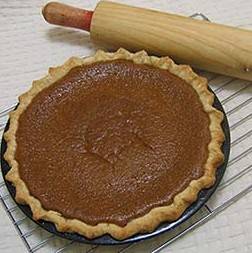 Last Thanksgiving, I reworked the filling of the classic pumpkin pie, making it custardy instead of rubbery. This year, it’s time to tackle crust from scratch. You can do this, and you even have a few weeks to practice before the big day.
Last Thanksgiving, I reworked the filling of the classic pumpkin pie, making it custardy instead of rubbery. This year, it’s time to tackle crust from scratch. You can do this, and you even have a few weeks to practice before the big day.
The most common problems with pie crust have to do with overworking and stretching the dough. Having all the ingredients chilled before you start can help prevent this. If necessary, you can freeze the butter and grate it into the flour, and even throw the flour in the fridge for an hour before you start.
Pie crust is the opposite of bread. You want to avoid developing the gluten in the flour. This means working the dough as gently and as little as possible. Remember that the moisture level of flour can change depending upon the conditions it has been stored in (in your house and on the journey to you) and current humidity levels. Also, a flaky crust needs a hot oven, so always be sure to preheat yours.
Flaky Butter Pie Crust (makes a single 9″ crust)
- 1 c all purpose flour, plus up to ¼ c more for dusting counter and working dough
- 7 T very cold butter or combination of butter and shortening (5 T butter, 2 T shortening)
- 1/8 t salt
- 3 T ice water (possibly slightly less or more depending upon flour moisture)
Cut butter into tablespoons. Place into food processor with 1 c of flour, and salt. Pulse the mixture until you have something that looks like coarse meal with a few tiny pea-sized pieces, as well. This should take about six to eight pulses depending upon how cold the butter is. Add the ice water and pulse 6 to 10 times until the pastry just begins to hold together as tiny butter balls. Do not let the dough form a big ball. Remove it from the processor. Gathering it together with your hands, gently press it into a cohesive ball. Then press it gently into a disk. Wrap the dough with wax paper, parchment, or plastic film and chill for 30 minutes to 1 hour.
No food processor? Cut the butter into tablespoons and then each tablespoon into quarters. If using shortening, no need to pre cut. Using a pastry cutter, fork, or your hands, slowly cut the butter with the flour and salt. If using your hands, pick up handfuls of the mixture and gently rub them into flour covered butter flakes by taking your thumbs over your finger tips. When the mixture resembles coarse meal with a few pea-sized pieces, add water, mixing until the dough just comes together. Gather dough gently into a cohesive ball. Pat into a disk. Wrap and refrigerate as above.
Preheat oven to 375 degrees while dough chills. After dough is chilled, dust it generously with flour and gently roll out on a lightly floured counter with a floured rolling pin, straight sided glass bottle, or a large can of soda/beer (Fosters works well in a pinch). Do not press down heavily on the rolling pin. Let the weight of the rolling pin do the work. Turn the dough in quarter turns to keep it round. You can also flip it periodically and re-dust with flour, if necessary, to keep it from sticking. Avoid stretching the dough as this will make it shrink during baking. You can watch this process here. Though try to go a little easier with the rolling pin and don’t be as stingy with the flour as there is less flour in this dough recipe than the one in the video.
When the dough is rolled to size, about 1 ¼ times the size of the pie pan, place rolling pin on the back edge of it. Pick up the dough and hold it against the pin. Roll the pin toward you, picking up the dough from the counter as you go. Then simply unroll it over the pie pan. Let it fall into place. Ease the dough into the pan by lifting the outer edge, do not pull or stretch it to make it fit. Trim to about a half-inch to an inch-wider than pan. Patch any cracks, gaps, or holes with excess dough.
Need a visual? Fold trimmed edges of dough under so that they rest on the rim of the pan. Lift folded edge slightly upward. Pinch or finish as desired. You can see a variety of finishes here.
Line pie pan with parchment/foil and fill with a layer of beans or ceramic pie weights. Bake crust for 20 minutes at 375 degrees. Remove weights. Add filling and bake another 40 minutes. This ensures a crisp crust with a moist filling. (Note if you use a tart pan you will only bake for 20 minutes as the depth is half that of the pie pan.)
If your pie crust didn’t turn out like you expected, check this troubleshooting guide.








